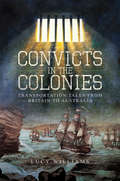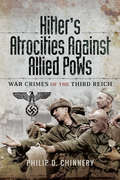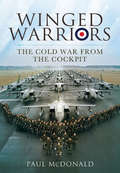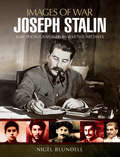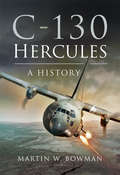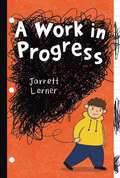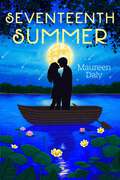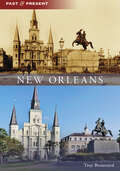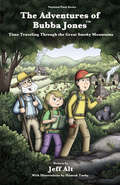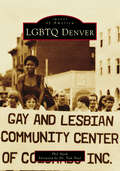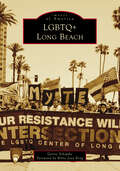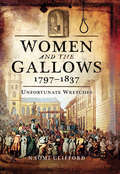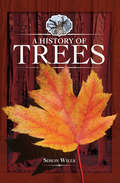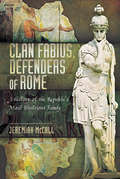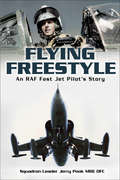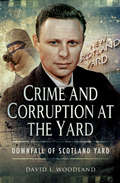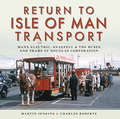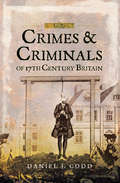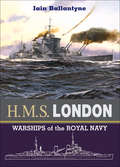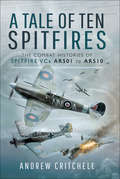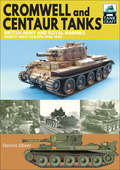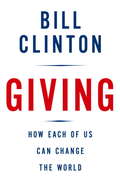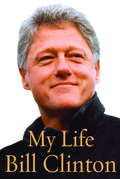- Table View
- List View
Convicts in the Colonies: Transportation Tales from Britain to Australia
by Lucy Williams&“A book that looks deeply into the lives of some of the convicts who were sentenced in court to be transported to Botany Bay.&” —Pirates and Privateers In the eighty years between 1787 and 1868 more than 160,000 men, women and children convicted of everything from picking pockets to murder were sentenced to be transported beyond the seas. These convicts were destined to serve out their sentences in the empires most remote colony: Australia. Through vivid real-life case studies and famous tales of the exceptional and extraordinary, Convicts in the Colonies narrates the history of convict transportation to Australia—from the first to the final fleet. Using the latest original research, Convicts in the Colonies reveals a fascinating century-long history of British convicts unlike any other. Covering everything from crime and sentencing in Britain and the perilous voyage to Australia, to life in each of the three main penal colonies—New South Wales, Van Diemen&’s Land, and Western Australia—this book charts the lives and experiences of the men and women who crossed the world and underwent one of the most extraordinary punishments in history. &“An easily read, fascinating history, telling the tales of the &‘recidivist&’ convicts in the 18th and 19th centuries.&” —The Essex Family Historian
Hitler's Atrocities Against Allied PoWs: War Crimes of the Third Reich
by Philip D. Chinnery“A chilling description of the ordeals that captured men and women were put through by the Third Reich regime and their Italian allies.” —Daily MailSeventy years ago, the Nuremberg Trials were in full swing in Germany. In the dock were the leaders of the Nazi regime and most eventually received their just desserts. But what happened to the other war criminals?In June 1946, Lord Russell of Liverpool became Deputy Judge Advocate and legal adviser to the Commander in Chief for the British Army of the Rhine in respect of all trials held by British Military Courts of German war criminals. He later wrote:“At the outbreak of the Second World War, the treatment of prisoners was governed by the Geneva Prisoner of War Convention of 1929, the Preamble of which stated that the aim of the signatories was to alleviate the conditions of prisoners of war.“During the war, however, the provisions of the Convention were repeatedly disregarded by Germany. Prisoners were subjected to brutality and ill-treatment, employed on prohibited and dangerous work, handed over to the SD for ‘special treatment’ in pursuance of Hitler’s Commando Order, lynched in the streets by German civilians, sent to concentration camps, shot on recapture after escaping, and even massacred after they had laid down their arms and surrendered.”Tens of thousands of Allied prisoners of war died at the hands of the Nazis and their Italian allies. This book is for them lest we forget.“A sobering and harrowing book, detailing many forgotten crimes committed against POWs who should have been offered the protection of the Geneva Convention, but tragically were not.” —Recollections of WWII
Winged Warriors: The Cold War from the Cockpit
by Thomas McDonaldPaul McDonald is a former RAF fast-jet pilot whose flying career spanned 34 years. He is not a typical senior RAF officer having been brought up on a council estate in a bleak northern industrial town. He became a pilot by accident and struggled to gain his wings. He spent 14 years on operational tours overseas including 2 tours at the height of the Cold War on a Tornado tactical nuclear squadron in Germany, only 15 minutes from responding to an anticipated Soviet onslaught. Earlier he served on a low-level photo reconnaissance squadron on NATO's vulnerable southern flank. He was decorated for gallantry in 1980 and later served in Kuwait as the Senior RAF Adviser, including Operation Desert Fox, the air war against Iraq in 1998.
Joseph Stalin: Images Of War (Images of War)
by David A. SemeraroJoseph Stalin was a monster. He sacrificed his friends and allies in pursuit of power, murdered thousands with sadistic brutality to maintain it and callously obliterated millions more of his own people over a quarter century of his leadership. Yet almost as frightening as the horrendous crimes he committed is the idolatry that allowed this ogre to flourish. Just like fellow monster of the twentieth century Adolf Hitler, Stalin saw himself as a master of destiny, a role that to him excused the vilest atrocities. And, bafflingly, just like his Nazi counterpart, he was allowed to dominate his nation and overrun others with the enthusiastic support of the majority of the citizens whom he had subjugated. Stalin was lauded as a national savior right up until his death, which was marked by mourning crowds so vast that untold numbers perished in the crush. This unquestioning adulation is not only a mystery to todays historians but a cause for alarm. For, under the Soviet Unions present regime, there are signs that the Stalin cult is being resurrected as the Russian bear again sharpens its claws. This concise book presents a cautionary study, in words and historic photographs, of the peasants son from Georgia who as a choirboy seemed destined for the priesthood but who grew up to be a street-fighting revolutionary using torture and terror as tools to attain power. It asks how the coarse, brutish drunkard that he became could nevertheless have been lauded abroad as a cultural giant and spellbind so many millions at home as an object of worship. It provides clues as to how Stalin the military incompetent came to be seen as a statesman of equal standing to war leaders like Churchill and Hitler (whose lives are covered by companion volumes in the Pen & Sword Images of War series). And it points to the danger of rewriting history to allow the resurrection of Stalin as a father of his people in the twenty-first century rather than a bloodstained idol with feet of clay.Also Available by Nigel Blundell, from the Images of War series, Images of War Winston Churchill and Images of War Adolf Hitler.
C-130 Hercules: A History
by Martin W. Bowman&“An engaging retrospective on the long-lived and ubiquitous C-130 Hercules tactical airlifter . . . Sweeping in its scope . . . an invaluable reference.&” —Aviation History Designed in response to a 1951 requirement, the C-130 Hercules is the most successful military airlifter ever built. Since it first flew in prototype form on August 23, 1954, more than 2,100 have been produced in over eighty different versions. Across its variants, the Hercules serves more than sixty air forces, as well as many civilian cargo operators, in a multiplicity of roles, including air-to-air refueller, gunship, airborne command post, flying hospital, and firefighter. This rugged and easily maintained aircraft entered service in 1956 with the USAF Tactical Air Command. Ten years later, the &“Charlie 130&” was providing essential logistical support in Vietnam. This period in Southeast Asia was the Hercules&’ finest hour. Paradrops, airlift, and evacuation operations were completed around the clock, often at low level, usually under fire and nearly always in bad weather. A generation later, this &“Mr. Dependable&” was serving with equal distinction in the Gulf War in the role of airlifter, radio-countermeasures, and &“psy-ops&” platform, gunship and, once again, &“block-buster bomber.&” The &“Herky Bird&” or &“Fat Albert,&” as the C-130 is fondly known, has proved a key component in humanitarian relief operations, as well, in all parts of the world. &“Martin&’s technical and informative look at their creation and use is absolutely fascinating. An iconic aircraft gets Martin&’s VIP treatment in this wonderful book.&” —Books Monthly &“A history of an aviation great, from the pen of a popular and well-established author of aviation history.&” —Firetrench
A Work in Progress
by Jarrett LernerA young boy struggles with body image in this poignant and &“perceptive&” (Publishers Weekly, starred review) middle grade journey to self-acceptance told through prose, verse, and illustration.Will is the only round kid in a school full of thin ones. So he hides…in baggy jeans and oversized hoodies, in the back row during class, and anywhere but the cafeteria during lunch. But shame isn&’t the only feeling that dominates Will&’s life. He&’s also got a crush on a girl named Jules who he knows he doesn&’t have a chance with, because of his size—but he can&’t help wondering what if? Will&’s best shot at attracting Jules&’s attention is by slaying the Will Monster inside him by changing his eating habits and getting more exercise. But the results are either frustratingly slow or infuriatingly unsuccessful, and Will&’s shame begins to morph into self-loathing. As he resorts to increasingly drastic measures to transform his appearance, Will meets skateboarder Markus, who helps him see his body and all it contains as an ever-evolving work in progress.
Seventeenth Summer
by Maureen DalyUntil the summer before college, Angie Morrow didn't really date. Her mother didin't like her to go out much. But no one -- not even Angie's mother -- can resist the charm of strikingly handsome Jack Duluth. His good looks grab Angies's attention from the moment in June when Jack throws Angie a smile at McKight's drugstore. And on their first date sailing under the stars -- when Jack leans in and whispers to Angie, "You look nice with the wind in your hair," the strange new feeling s begin. Tingles, prickles, warmth: the tell-tale signs of romance. It's the beginning of an unforgettable summer for Angie, full of wonder, warmth, tears, challenge, and love. Maureen Daly had created a love story so honest that it has withstood the test of time, winning new fans for more than six decades. Today, this classic is enjoyed by many who think of it as the quintessential love story, and as a glimpse of love in the 1940's; a refreshing alternative to modern love stories, reflecting the beauty and innocence of new love.
Consider Me (Playing for Keeps #1)
by Becka MackIn the sizzling hockey romance that has taken TikTok by storm, the ultimate player turns romantic to charm the woman he is desperate to win over. &“Endlessly sexy and funny. Consider Me will have you fanning yourself and googling your closest hockey team hangout.&” —Hannah Grace, New York Times bestselling author of Wildfire and Icebreaker The first book in the globally popular Playing for Keeps series.For a shot at love, he&’ll do whatever it takes… Carter Beckett is the NHL&’s best player—both on and off the ice. His career is at its peak, his friends are performing better than ever, and there&’s no shortage of women to spend the night with. What more could he want? Olivia Parker isn&’t new to professional hockey players, thanks to her best friend&’s boyfriend, but she has no interest in dating one herself—no matter how hot he is. And anyway, she loves working as a teacher and hanging out with her best friend, drama-free. Why would she want to spend her time stroking the ego of an arrogant athlete? But once Carter meets Olivia, he can&’t think of anything else. Too bad for him, Olivia is hellbent on keeping him at arm&’s length, with no intention of giving into his charms. Perhaps it&’s time for Carter to up his game…after all, nobody said he had to play fair. Sparks will fly as Carter does whatever it takes for Olivia to consider him.
Sixteenth Summer (Sixteenth Summer)
by Michelle DaltonThis sweet summer romance about &“the floaty happiness of first love&” (BCCB) between a girl living in a beachside island town and a city boy is perfect for fans of Jenny Han and Morgan Matson.Anna is dreading another tourist-filled summer on Dune Island that follows the same routine: beach, ice cream, friends, repeat. That is, until she locks eyes with Will, the gorgeous and sweet guy visiting from New York. Soon, her summer is filled with flirtatious fun as Anna falls head over heels in love. But with every perfect afternoon, sweet kiss, and walk on the beach, Anna can&’t ignore that the days are quickly growing shorter, and Will has to leave at the end of August. Anna&’s never felt anything like this before, but when forever isn&’t even a possibility, one summer doesn&’t feel worth the promise of her heart breaking…
The Adventures of Bubba Jones: Time Traveling Through the Great Smoky Mountains (A National Park Series #1)
by Jeff Alt Hannah TuohyTommy "Bubba Jones" and his sister Jenny "Hug-a-Bug" learn more about the Great Smoky Mountain National Park than they ever thought they would when Papa Lewis lets them in on a family secret: The family has legendary time traveling skills! With these abilities, Bubba Jones and Hug-a-Bug travel back in time and meet the park’s founders, its earliest settlers, native Cherokee Indians, wild animals, extinct creatures, and what the park was like millions of years ago. With this time traveling ability also comes a family mystery, but the only person who can help solve the mystery is a long lost relative who lives somewhere in the park. Explore the Smokies with Bubba Jones and family in a whole new way.
Women and the Gallows, 1797–1837: Unfortunate Wretches
by Naomi CliffordThis true crime history of Georgian England reveals the scandalous lives—and unceremonious deaths—of more than 100 women who faced execution.In the last four decades of the Georgian era, 131 women were sent to the gallows. Unlike most convicted felons, none of them were spared by an official reprieve. Historian Naomi Clifford examines the crimes these women committed and asks why their grim sentences were carried out.Women and the Gallows, 1797–1837 reveals the harsh and unequal treatment women could expect from the criminal justice system of the time. It also brings new insight into the lives and the events that led these women to their deaths. Clifford explores cases of infanticide among domestic servants, counterfeiting, husband poisoning, as well as the infamous Eliza Fenning case.This volume also includes a complete chronology of the executed women and their crimes.
A History of Trees
by Simon WillsMake Arbor Day every day with little known and intriguing facts about the plants that populate our forests, give us shade, and clean our air. Have you ever wondered how trees got their names? What did our ancestors think about trees, and how were they used in the past? This fascinating book will answer many of your questions, but also reveal interesting stories that are not widely known. For example, the nut from which tree was predicted to pay off the UK&’s national debt? Or why is Europe&’s most popular pear called the &“conference&”? Simon Wills tells the history of twenty-eight common trees in an engaging and entertaining way, and every chapter is illustrated with his photographs. Find out why the London plane tree is so frequently planted in our cities, and how our forebears were in awe of the magical properties of hawthorn. Where is Britain&’s largest conker tree? Which tree was believed to protect you against both lightning and witchcraft? The use of bay tree leaves as a sign of victory by athletes in ancient Greece led to them being subsequently adopted by many others—from Roman emperors to the Royal Marines. But why were willow trees associated with Alexander Pope, Napoleon Bonaparte, and Samuel Johnson? Why did Queen Anne pay a large sum for a cutting from a walnut tree in Somerset? Discover the answers to these and many other intriguing tales within the pages of this highly engrossing book.
Clan Fabius, Defenders of Rome: A History of the Republic's Most Illustrious Family
by Jeremiah McCallThe history of the Fabii Maximii is in many ways that of the Roman Republic. In the legends and historical scraps that survived the Republic, the members of the Fabius clan were, more often than not, the hammers that forged the empire. Few families contributed more to the survival and success of the Republic and for so many centuries. Few could boast such great glories; perhaps none could match the record of Fabian offices and honours in the Republic. Though the bloodline sank into obscurity in the early empire, the name still carried memories of great achievements past.A historical detective work, this book explores the facts and fables of the Republics most distinguished family. Chapters investigate not only the lives and careers of the Fabii Maximi, but the critical military and political contexts of their days. As a result, readers get not only the story of the Roman Republics rise and domination of an empire, but a closer look at a family of Romans who made it possible.
Flying Freestyle: An RAF Fast Jet Pilot's Story
by Jerry PookA British Royal Air Force pilot recounts his 25-year career in the cockpit during the Cold War in this military memoir. During a twenty-five-year flying career in the RAF, Jerry Pook has flown Hunter Fighter/Ground Attack aircraft in the Gulf, Harriers in West Germany, the supersonic Starfighter with the Dutch Air Force, the Harrier in Belize, Central America and the Tornado bomber at the Tri-national Tornado Training Establishment where he trained German and Italian pilots and navigators. Jerry had a long relationship with the Harrier Fighter/Ground Attack vertical take-off aircraft. This he flew in West Germany at the height of the Cold War operating from Wildenrath and off-base operations with Field Wing operations based in the fields and woods of the German countryside. Jerry saw action during the Falklands War when based on HMS Hermes and flying one of the few RAF Harriers in the Ground Attack role in support of the troops fighting ashore. He then enjoyed flying the American-built Starfighter RF 104G during a three-year exchange tour with the Dutch Air Force—he describes the Starfighter as &“beautiful to fly, smooth and sophisticated, supremely fast and powerful—if you took liberties with it you knew it would kill you in an instant.&” After three years with No 1 (Fighter) Squadron and again flying the Harrier, he moved to the then new Tornado, flying in its bomber role. This he continued to fly operationally and in the instructional role for thirteen years until grounded from military flying for medical reasons.
Crime and Corruption at the Yard: Downfall of Scotland Yard
by David I. WoodlandA Scotland Yard insider blows the whistle on police corruption in &“a book . . . that everyone concerned with law and order should read&” (Crime Review). During David Woodland&’s nineteen years of service with the United Kingdom&’s Metropolitan Police, the &‘thin blue line&’ came under intense pressure. In addition to the routine caseload of gang crime, murder, and armed robbery, Irish terrorist groups launched a vicious and prolonged campaign of violence. Also, then-Police Commissioner Sir Robert Marks described the Criminal Intelligence Department as &‘the most routinely corrupt organization in London&’, it may have been an exaggeration made out of anger—but it devastated the public&’s faith in the CID. New Scotland Yard Det. Inspector David Woodland was witness to a series of major scandals and now reveals why many otherwise honest detectives strove to bend the law to their own devices. Using his own cases and experience, he demonstrates the difficulties working in a depleted, demoralized police force—not to mention fighting to overcome &‘the enemy within&’. Crime and Corruption at The Yard is a gripping, shocking, and instructive insider&’s account of the darker side of police work.
Return to Isle of Man Transport: Manx Electric, Snaefell & the Buses and Trams of Douglas Corporation
by Martin Jenkins Charles RobertsThis is the second book by Martin Jenkins and Charles Roberts, about transport in the Isle of Man.The first volume covered the railway network, where as this new volume covers all other forms, road, rail, sea and air operations.The book is illustrated, using previously unpublished rare early color pictures, from the Online Transport Archive, which holds over a million transport images.Both the authors have managed to collect some truly interesting and often stunning pictures, from a period when color coverage of transport subjects was almost non existent.
Crimes & Criminals of 17th Century Britain
by Daniel J. CoddThink the world is bad today? Then take a true-crime trip back in time to 1600s England, where violence, robbery, and cold-blooded murder ran amuck. These days, criminals and evildoers are stopped, caught, and punished every day. But how did people deal with crimes before the police, computer records, and a consistent judicial system even existed? Here are the stories of some of the most heinous, shocking, and unbelievable transgressions of the law in seventeenth century England, raising questions such as . . . Which murderer committed an atrocity at an East End brothel in 1691?What superstitions lay behind the unfathomable slaughter of three innocent children at a remote farmhouse in County Durham in 1683?When was a parish constable murdered in cold blood by a party of men that allegedly included the illegitimate son of King Charles II?Where did deadly confrontations occur between supporters and opponents of King James II during the so-called Bloodless Revolution of 1688? These cases, and many more, are explored in depth, harkening back to a time of witch hunts, dueling, and political assassinations, when the punishment for killing one&’s fellow man was either more barbaric than the crime itself, or corruptly lenient. Illustrated throughout and shedding a unique light on the era, Crimes & Criminals of 17th Century Britain is the first work of its kind to explore the monstrous murders that occurred at a time when the nation was repeatedly plunged into chaos.
HMS London: Warships of the Royal Navy
by Iain BallantyneA fascinating and lively account of the lives of British warships named London, looking at history from the perspective of the men who were there. There is no current warship in the Royal Navy called HMS London, but vessels carrying the name have featured in some of the most controversial episodes of British naval history. For example, the wooden wall battleship HMS London of the late 18th century could be called &“the ship that lost America&” while the heavy cruiser of WW2 was command vessel for the escort force that failed to safeguard the controversial convoy PQ17. Examining the stories of HMS Londons all the way from the English Civil War, through the Battle of Copenhagen in 1801—where Nelson famously ignored signals to break off the action displayed by HMS London—we also learn of the pre-dreadnought London&’s participation in the ill-fated Dardanelles campaign of WW1. Among the people Iain Ballantyne interviewed for this book were veterans of the Arctic convoys of WW2, the Yangtse Incident and warriors of the Cold War and 1991 Gulf War. It all adds up to a thoroughly researched and exciting narrative of naval history. Adding to the authenticity of the tale, Iain even sailed to Russia in the last HMS London, a Type 22 guided-missile frigate, in August 1991. During a WW2 convoy re-enactment the ship was almost hit by a practice torpedo launched from a Soviet submarine and had to take evasive action.
A Tale of Ten Spitfires: The Combat Histories of Spitfire VCs AR501 to AR510
by Andrew CritchellThe Fw190s supremacy over the Spitfire V is a classic legend from the Second World War, heralding one of the darkest times for Fighter Command and the RAF. _A Tale of Ten Spitfires_ brings this legend to life by examining the individual combat histories of ten Spitfire VCs, the first of which is the Shuttleworth Collections well known Spitfire AR501, followed by the next nine on the production line, AR502 to AR510.This link to a living airframe, whose first flight after a lengthy restoration is imminent, provides an ideal hook for the enthusiast and also members of the wider public with a more general interest in this classic British icon.Through first hand accounts, combat reports, unit diaries and more, the book provides a unique looking glass into the period, told via the experiences of the Spitfire pilots themselves, tracing their fates and those of the ten machines that they flew.
Cromwell and Centaur Tanks: British Army and Royal Marines, North-west Europe, 1944–1945 (Tank Craft Ser. #16)
by Dennis Oliver&“An excellent resource for one just starting out trying to model one of these beasts . . . great background information.&” —AMPS Designed with the hard lessons of the North African campaign in mind, including the adoption of a dual-purpose gun capable of firing high-explosive and anti-tank rounds, the Cromwell was one of the most successful of the British cruiser tanks produced during the Second World War. The lack of heavy armor was made up for by the tank&’s high speed, provided by a Rolls-Royce Meteor engine. The Centaur was externally almost identical to the Cromwell, the major difference being the installation of the less powerful Liberty engine. While the Centaur equipped the Royal Marines during the Normandy battles, the Cromwell served until the end of the war and formed the basis for the Comet. In his fifth book in the TankCraft series, author and illustrator Dennis Oliver uses official wartime photographs and comprehensively researched, exquisitely presented color profiles to tell the story of the penultimate British cruiser tank. As with all the titles in the TankCraft series, the large full-color section features available model kits and accessories as well as aftermarket products. In addition to the color profiles, there is a gallery of expertly constructed and painted models. A separate section explains technical details and modifications made during production and in the field, giving the modeler all the information required to create an authentic replica of one of the tanks that served from the Normandy beaches to the final battles in Germany.
Giving: How Each Of Us Can Change The World
by Bill ClintonHere, from Bill Clinton, is a call to action. Giving is an inspiring look at how each of us can change the world. First, it reveals the extraordinary and innovative efforts now being made by companies and organizations—and by individuals—to solve problems and save lives both “down the street and around the world.” Then it urges us to seek out what each of us, “regardless of income, available time, age, and skills,” can do to help, to give people a chance to live out their dreams.Bill Clinton shares his own experiences and those of other givers, representing a global flood tide of nongovernmental, nonprofit activity. These remarkable stories demonstrate that gifts of time, skills, things, and ideas are as important and effective as contributions of money. From Bill and Melinda Gates to a six-year-old California girl named McKenzie Steiner, who organized and supervised drives to clean up the beach in her community, Clinton introduces us to both well-known and unknown heroes of giving. Among them:Dr. Paul Farmer, who grew up living in the family bus in a trailer park, vowed to devote his life to giving high-quality medical care to the poor and has built innovative public health-care clinics first in Haiti and then in Rwanda;a New York couple, in Africa for a wedding, who visited several schools in Zimbabwe and were appalled by the absence of textbooks and school supplies. They founded their own organization to gather and ship materials to thirty-five schools. After three years, the percentage of seventh-graders who pass reading tests increased from 5 percent to 60 percent;'Oseola McCarty, who after seventy-five years of eking out a living by washing and ironing, gave $150,000 to the University of Southern Mississippi to endow a scholarship fund for African-American students;Andre Agassi, who has created a college preparatory academy in the Las Vegas neighborhood with the city’s highest percentage of at-risk kids. “Tennis was a stepping-stone for me,” says Agassi. “Changing a child’s life is what I always wanted to do”;Heifer International, which gave twelve goats to a Ugandan village. Within a year, Beatrice Biira’s mother had earned enough money selling goat’s milk to pay Beatrice’s school fees and eventually to send all her children to school—and, as required, to pass on a baby goat to another family, thus multiplying the impact of the gift.Clinton writes about men and women who traded in their corporate careers, and the fulfillment they now experience through giving. He writes about energy-efficient practices, about progressive companies going green, about promoting fair wages and decent working conditions around the world. He shows us how one of the most important ways of giving can be an effort to change, improve, or protect a government policy. He outlines what we as individuals can do, the steps we can take, how much we should consider giving, and why our giving is so important.Bill Clinton’s own actions in his post-presidential years have had an enormous impact on the lives of millions. Through his foundation and his work in the aftermath of the Asian tsunami and Hurricane Katrina, he has become an international spokesperson and model for the power of giving.“We all have the capacity to do great things,” President Clinton says. “My hope is that the people and stories in this book will lift spirits, touch hearts, and demonstrate that citizen activism and service can be a powerful agent of change in the world.”
My Life: My Life In The Colorful World Of New Jersey Politics
by Bill ClintonPresident Bill Clinton’s My Life is the strikingly candid portrait of a global leader who decided early in life to devote his intellectual and political gifts, and his extraordinary capacity for hard work, to serving the public. It shows us the progress of a remarkable American, who, through his own enormous energies and efforts, made the unlikely journey from Hope, Arkansas, to the White House—a journey fueled by an impassioned interest in the political process which manifested itself at every stage of his life: in college, working as an intern for Senator William Fulbright; at Oxford, becoming part of the Vietnam War protest movement; at Yale Law School, campaigning on the grassroots level for Democratic candidates; back in Arkansas, running for Congress, attorney general, and governor.We see his career shaped by his resolute determination to improve the life of his fellow citizens, an unfaltering commitment to civil rights, and an exceptional understanding of the practicalities of political life.We come to understand the emotional pressures of his youth—born after his father’s death; caught in the dysfunctional relationship between his feisty, nurturing mother and his abusive stepfather, whom he never ceased to love and whose name he took; drawn to the brilliant, compelling Hillary Rodham, whom he was determined to marry; passionately devoted, from her infancy, to their daughter, Chelsea, and to the entire experience of fatherhood; slowly and painfully beginning to comprehend how his early denial of pain led him at times into damaging patterns of behavior.President Clinton’s book is also the fullest, most concretely detailed, most nuanced account of a presidency ever written—encompassing not only the high points and crises but the way the presidency actually works: the day-to-day bombardment of problems, personalities, conflicts, setbacks, achievements.It is a testament to the positive impact on America and on the world of his work and his ideals.It is the gripping account of a president under concerted and unrelenting assault orchestrated by his enemies on the Far Right, and how he survived and prevailed. It is a treasury of moments caught alive, among them:• The ten-year-old boy watching the national political conventions on his family’s new (and first) television set.• The young candidate looking for votes in the Arkansas hills and the local seer who tells him, “Anybody who would campaign at a beer joint in Joiner at midnight on Saturday night deserves to carry one box. . . . You’ll win here. But it’ll be the only damn place you win in this county.” (He was right on both counts.)• The roller-coaster ride of the 1992 campaign.• The extraordinarily frank exchanges with Newt Gingrich and Bob Dole.• The delicate manipulation needed to convince Rabin and Arafat to shake hands for the camera while keeping Arafat from kissing Rabin.• The cost, both public and private, of the scandal that threatened the presidency.Here is the life of a great national and international figure, revealed with all his talents and contradictions, told openly, directly, in his own completely recognizable voice. A unique book by a unique American.
